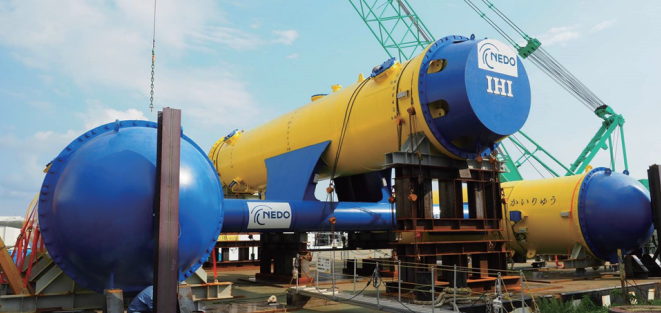A wellspring of power unlike any other can be found in the deep seas. To harness such power, Japanese engineers built a real leviathan, a beast capable of resisting the most powerful ocean currents and converting its flow into an almost unlimited supply of electricity.

The Kairyu
Ishikawajima-Harima Heavy Industries, which is now commonly known as IHI Corporation, has been experimenting with the technology for over a decade and teamed with the New Energy and Industrial Technology Development Organization (NEDO) in 2017 to materialize their concepts.
The project reached a crucial breakthrough in February when a three-and-a-half-year field test off Japan's southwestern coast was completed successfully.
Kairyu is the name given to the 330-ton prototype, which roughly translates to "ocean current." It had a 20-meter or 66-foot-long fuselage flanked by two cylinders of equal size, each holding a power generation system connected to an 11-meter long turbine blade.
The device can configure itself to locate the most optimal place to generate power from the push of a deep-water current and feed it into a grid when it is anchored to the ocean floor by power cables and an anchor line.
To generate a substantial portion of its power, Japan is significantly reliant on fossil fuel imports. Japan is encouraged to exploit its technical expertise to reap the benefits of renewable energy sources, as public opinion against nuclear power has worsened since the Fukushima nuclear accident in 2011.
But according to Science Alert, the mountainous Japanese archipelago does not lend itself to enormous wind turbine forests or solar panel fields. Because of its remote position, there is also less potential to manage renewable energy swings through the energy trade.
The country does feature extensive areas of coastal water. The ocean rushes to the east under the power of the North Pacific gyre. The gyre eventually collides with Japan creating strong Kuroshio currents.
Read also : Offshore Wind Turbine Farm In Rhode Island Hasn't Harmed The Local Fish Population: Study
IHI's Forecast
IHI predicts that if the energy in the current could be harvested, it could produce around 205 gigawatts of electricity, which is roughly equivalent to the country's overall power generation.
The ocean's chaotic motions have so much potential that harnessing it as a power source is difficult. The quickest-moving waters are at the surface, where typhoons may readily devastate power plants.
Kairyu was constructed to float 50 meters beneath the waves, with the drag produced providing the necessary torque to the turbines as they approached the surface. Each blade also rotates in the opposite direction, ensuring that the device remains fairly stable.
Despite massive interest in this untapped source of renewable energy, Science Alert noted that attempts to extract watts from the open ocean usually fail. This is due to costly engineering expenses, environmental restrictions, and the accessibility of coastal areas to the grid that pose great challenges in completing such a project.
But if IHI Corp succeeds with this project, they will reap vast amounts of benefits with ocean power possibly providing anything between 40 to 70% of Japan's energy demands.
Related Article : Ocean Winds and Principle Power Announce Collaboration for France's First Commercial-Scale Floating Offshore Wind Tender
This article is owned by Tech Times
Written by Joaquin Victor Tacla




